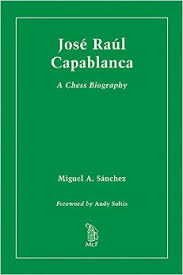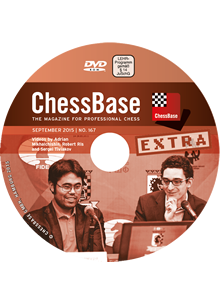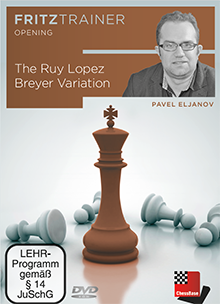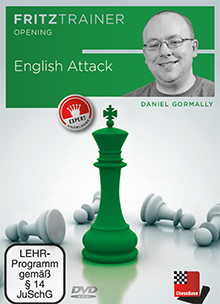 José
Raúl Capablanca
José
Raúl Capablanca
A Chess Biography
Miguel A. Sánchez
Foreword by Andy Soltis
2015
McFarland &
Company,Inc.,Publishers Box 611
Jefferson,North Carolina 28640.
http://www.mcfarlandpub.com
553 pages
Price $55.00
Print ISBN: 978-0-7864-7004-4
Ebook ISBN: 978-1-4766-1499-1
195 annotated games, 55 photos, 100 +
annotated games, appendices, notes, bibliography, indexes
568pp. library binding (7 x 10) 2015
This biography from Miguel A Sanchez on the chess legend Jose
Raul Capablanca is the best that I have ever seen on one of the
greatest chess players of all time.
As Andy Soltis writes in his foreword on this book; Today,more than 70
years since his death,we still ask questions about many aspects of
Capa’s life.
Among the many: How did he become a prodigy and later seem to improve
so much during 1906-1907?How could he master chess without books?
In this book you will find Jacques Mieses shedding some light when he
is quoted as saying that Capa” gave practically all of his time
to chess ”.
This current book from Miguel A Sanchez on Capa took as its
source from the Spanish edition that was published in Cuba 1978 with
the title Capablanca,Leyenda y Realidad,but seen all the abundance of
new material we must speak of a complete new book.
As the author bescribes: further research comprises more than
half
of the present work.
Gaps and errors have been corrected. Accounts of Cabablanca’s personal
life have been expanded and unexplored parts of his background have
been revealed; among them,a new chapter dedicated to his ancestors, a
theme not touched by his previous biographers.
The book also contains the diplomatic file of Capablanca {the
Capablanca Diplomatic Compendium,ofthen cited in the notes}, released
in Havanna 2002 by the Ministry of Foreign Affairs of Cuba.Similary,a
revealing new account of the Buenos Aires match in 1927 not only brings
new light to that extraordinary historical confrontation but puts into
perspective the role of Capablanca in arranging the match, through
correspondence with Alexander Alekhine and the Argentine Chess Club.
This work also seeks to investigate Capablanca’s natural and
extraordinary gift for chess.Capablanca also suffered a mysterious
lapsus in the process of chess thinking.Later such episodes were
identified as Lacunar crises {isolated patches of memory loss}caused by
his uncontrolled arterial hypertension.
But Capablanca is by statistics one of the players with the lowest
percentage of blunders where some compare his play with a chess
machine,at one stage of his career Capablanca lost only one tournament
game in ten year.Never published in a book before from the legendary
Cuban are two appendices, the first one collects the articles
Capablanca wrote for the newspaper Critica before the world
championship in Buenos Aires,where he shares in depth his views about
the masters who preceded him.The second one presents the medical
research about his illness and death, by the neurologist Dr.Orlando
Hernandez – Meilan,who with his twin brother Manuel, also a
neurologist, previously wrote another clinical study about the results
of the Cuban’s autopsy.
Capablanca had throw his life the status of a movie star and Alekhine
described him as “Don Juan,” “Valentino” or Latin Lover.On page 226 we
see Capablanca in the company of a beautiful young woman unfortunately
in a unidentified position.
Capablanca played throw his life around 1200 tournament games so I am
pleased to see in this book a good collection of 192 instructive games
of chess,plus ten others between the lines,included some of his
memorable loses.
Capablanca player around 51 match games with each other,where Marshall
only managed to win two games with white in the 1910,several of them
are covered in this book but my favourite one is Capablanca,Jose Raul -
Marshall,Frank James [C89]
New York Manhattan CC New York, 1918
1.e4 e5 2.Nf3 Nc6 3.Bb5 a6 4.Ba4 Nf6 5.0-0 Be7 6.Re1 b5 7.Bb3 0-0 8.c3
d5 9.exd5 Nxd5 10.Nxe5 Nxe5 11.Rxe5 Nf6 12.Re1 Bd6 13.h3 Ng4 14.Qf3 Qh4
15.d4 Nxf2 16.Re2 Bg4 17.hxg4 Bh2+ 18.Kf1 Bg3 19.Rxf2 Qh1+ 20.Ke2 Bxf2
21.Bd2 Bh4 22.Qh3 Rae8+ 23.Kd3 Qf1+ 24.Kc2 Bf2 25.Qf3 Qg1 26.Bd5 c5
27.dxc5 Bxc5 28.b4 Bd6 29.a4 a5 30.axb5 axb4 31.Ra6 bxc3 32.Nxc3 Bb4
33.b6 Bxc3 34.Bxc3 h6 35.b7 Re3 36.Bxf7+ 1-0.
Please also see The World’s Greatest Chess Games from Burgess,Nunn and
Emms.
Conclusion: Strongly recommended!

ChessBase Magazine
extra issue 166
September 2015
Videos by Adrian Mikhalchishin, Robert Ris and Sergei
Tiviakov
ChessBase
http://www.chessbase.com
E-Mail
info@chessbase.com
ISSN 1432-8992
Euro 12.99
Adrian Mikhalchishin shows the user a repertoire idea against the
Nimzo Indian where black has to face an isolated d-pawn and that is as
we can learn from our experience teacher not a easy task!
Sergei Tiviakov presents his game against Razuvaev where he made
a brilliant
positional sacrifice!
And Robert Ris digs in one of the most famous games of all times:
Botvinnik-Capablanca from the famous tournament of AVRO 1938.
Again this magazine is good for a Hugh amount of games, exactly counted
39.097 games all played between June and August of this year.
One of my hobbies is collection Latvian games and on these ChessBase
files are always games you will find nowhere else: Sheikh,Nasarullah
(138) - Grainger,Charlie (111) [C40]
BCF-ch Soanes op Coventry (1), 31.07.2015
1.e4 e5 2.Nf3 f5 3.Nxe5 Nc6 4.Nxc6 dxc6 5.e5 Bc5 6.Qf3 Qe7 7.Qg3 Nf6
8.f3 Nh5 9.Qh3 Qxe5+ 10.Kd1 Bf2 11.Qxh5+ g6 12.Bd3 gxh5 13.Rf1 Bh4
14.g3 Bxg3 15.hxg3 Qxg3 16.Re1+ Kd8 17.c4 h4 18.b3 Bd7 19.Bb2 Re8
20.Bf6+ Kc8 21.Rxe8+ Bxe8 22.Bxf5+ Bd7 23.Be4 h3 24.Kc2 h2 25.Na3 Qg2
26.Kd3 h1Q 27.Rxh1 Qxh1 28.Nc2 Qh6 29.Bd4 b6 30.Be3 Qd6+ 31.Kc3 Kb7
32.Nd4 Re8 33.b4 Kb8 34.a3 h5 35.Kb3 h4 36.Ne2 Bf5 37.Bxf5 Rxe3+
38.dxe3 Qd1+ 0-1.
Or Arroyo Mateo,Jose Miguel (1937) - Molano Lafuente,Ismael (2112) [C40]
Barcelona Sant Marti op 17th Barcelona (5), 17.07.2015
1.e4 e5 2.Nf3 f5 3.Nxe5 Qf6 4.d4 d6 5.Nc4 fxe4 6.Nc3 Qg6 7.f3 exf3
8.Qxf3 Nf6 9.Bd3 Qg4 10.Qxg4 Bxg4 11.Ne3 Bd7 12.Ned5 Nxd5 13.Nxd5 Kd8
14.Bg5+ Kc8 15.0-0 c6 16.Ne7+ Kc7 17.Rf7 Na6 18.Bf5 Be8 19.Nd5+ Kb8
20.Rxf8 Rxf8 21.Be7 Rxf5 22.Bxd6+ Kc8 23.Ne7+ Kd7 24.Nxf5 Bg6 25.Rf1
Bxf5 26.Rxf5 Kxd6 27.Rf7 Re8 28.Rxg7 Re7 29.Rg8 Nb4 30.g4 Nxc2 31.g5
Nxd4 32.g6 hxg6 33.Rxg6+ Kc5 34.Rg5+ Kb6 35.Kg2 Re2+ 36.Kg3 Rxb2 37.h4
Rxa2 0-1.
Conclusion: This is a must have chess DVD!

TrainingOpeningFritztrainer
The Ruy Lopez Breyer Variation
by Pavel Eljanov
2015
http://www.chessbase.com
E-Mail info@chessbase.com
Price Euro 29.90
Pentium-Processor at 300 Mhz or higher, 64 MB RAM, Windows XP, Windows
Vista, Windows 7, DVD drive, mouse, soundcard
The Breyer System is based on the regrouping manoeuvre 1.e4 e5 2.Nf3
Nc6 3.Bb5 a6 4.Ba4 Nf6 5.0-0 Be7 6.Re1 b5 7.Bb3 d6 8.c3 0-0 9.h3
Nb8,this idea is attributed to the hypermodern Hungarian master Gyula
Breyer who only lived from 1894 till 1921.
The Breyer has been the favourite defence of two great world champions
Boris Spassky and Anatoly Karpov,both probably influenced by there
trainer Furman.
The secret of this systen is that the return of the knight to b8 can
not be regarded as a waste of time.
The well known Breyer expert Pavel Eljanov has packed this
impressive made and well loaded DVD with 14 video lectures,
analyses and a extra study database of 50 entries.
As we can see in the following analyses file the material is more than
impressive: 14.Bg5 h6 Bh4 ed cd [C95]
26.03.2015
1.e4 e5 2.Nf3 Nc6 3.Bb5 a6 4.Ba4 Nf6 5.0-0 Be7 6.Re1 b5 7.Bb3 0-0 8.c3
d6 9.h3 Nb8 10.d4 Nbd7 11.Nbd2 Bb7 12.Bc2 Re8 13.Nf1 Bf8 14.Bg5 h6
15.Bh4 exd4 16.cxd4 c5!? A good way to decline the piece sacrifice
after 16...g5. [16...g5 17.Nxg5 hxg5 18.Bxg5 Bg7 19.Ng3 c5 20.Nf5 cxd4
21.Qxd4,] 17.d5 looks logical, restricting the b7-bishop, though now
Black can create pressure on e4. [17.e5 was interesting. Now after
17...Bxf3 (17...dxe5!? 18.dxe5 Bxf3 19.Qxf3 transposition) 18.Qxf3 dxe5
19.dxe5 Nxe5 20.Qf5 Ned7 (20...Ng6 21.Rxe8 Qxe8 22.Bxf6 gxf6 23.a4 Rb8
24.axb5 axb5 25.Qh5 White obtains an initiative for a pawn.) 21.Ne3
(21.Nd2 g6 22.Qf3 Bg7 23.Ne4 Qb6; 21.Rxe8 Qxe8 22.Ne3 Qe5=) 21...g6
22.Qf3 Qb6 23.Bxg6 (23.a4 Rac8! (23...Bg7 24.axb5 (24.Nd5 Nxd5 25.Qxd5
Nf8 (25...Ne5 26.axb5 g5 27.Bg3 Rad8 28.Qe4 axb5÷) 26.axb5 axb5
27.Qxa8 Rxa8 28.Rxa8 g5 29.Bg3 c4÷) 24...Ne5! 25.Qf4 g5 26.Bxg5
hxg5 27.Qxg5 Nh7 28.Bxh7+ (28.Qh5 Nf6) 28...Kxh7 29.Nf5 Ng6 30.h4 axb5
31.Rxa8 Rxa8 32.Nxg7 Kxg7 33.h5 Qd8=) 24.axb5 axb5 25.Bxg6 Ne5 26.Qxf6
Qxf6 27.Bxf6 fxg6 28.Nd5 Nc6=) 23...Ne5 24.Qxf6 Qxf6 25.Bxf6 fxg6
26.Nd5 Nc6 (26...Nd3!? 27.Red1 c4 28.Nc7 Bc5©) 27.Red1 Rac8 28.a3
Re6 29.Bc3 Rd6 30.Nf6+ Kf7 31.Rxd6 Bxd6 32.Ne4 Be7 1/2 (32) Broniek,M
(2306)-Pinho,J (2366) ICCF 2010] 17...g6 [17...c4 18.Nd4 Qa5 (18...g6
19.Qd2 Bg7 20.f3 Rc8 21.Bf2 Nh5 22.g4f) 19.f3 g6 20.Bf2 Bg7
21.b3²] 18.b3 [18.Bg3 Nb6 19.b3 White restricts the b6-knight.
19...Bg7 20.Rc1 a5 Black plays on the queenside where he's a pawn up.
21.Bd3 c4 22.bxc4 bxc4 23.Bc2 Qc7 (23...Rc8 24.Rb1 Ba6 25.Nd4 Nfxd5
26.exd5 Rxe1 27.Qxe1 Bxd4 28.Qd2 Bc5 29.Qxh6 c3 30.Bxg6 (30.Nh2 Nxd5
31.Rd1) 30...fxg6 31.Qxg6+ Kh8=) 24.Bf4 (24.Nd4 Qc5) 24...c3 25.Bd3
Nfd7"] 18...Bg7 19.Rc1 [19.Rb1 a5 20.N3d2 (20.Bg3 Nb6 21.N3d2 (21.a4 b4
22.Bd3 Ba6 23.Bxa6 Rxa6 24.N1d2 Ra7 25.Bh2 Rae7 26.Qc2 Nh7 27.Re3 Ng5")
21...Ba6) 20...Ba6 21.Ne3 Qc7 22.Bd3 c4 (22...b4 23.Bxa6 Rxa6 24.Nec4
Nh5 25.Qf3 a4 26.g4 axb3 27.axb3 Nhf6 28.Bg3f; 22...Nh5 23.Be2 Nf4
24.Bf1 Nh5 25.g4 Nhf6 26.Qc2 Nb6"; 22...Nb6 23.Qe2) 23.bxc4 b4 24.Bc2
Nb6" (24...Nc5 25.Qf3 Nfd7 26.Ng4 Ne5 27.Nxe5 Bxe5 28.a3 Bc3 29.Red1
Kg7 30.Bg3) 25.a3 bxa3 26.Ra1 Nfd7 27.Rxa3 Qc5 28.Ra2 Nxc4 29.Ndxc4
Bxc4 30.Nxc4 Qxc4"] 19...a5 [19...Rc8 20.N3d2 a) 20.N1d2 c4 (20...Ne5
21.Nxe5 Rxe5 22.Qf3) 21.bxc4 bxc4 22.Nd4 (22.Rb1 Qc7 23.Bg3 c3 24.Nb3
Nb6 25.Qc1 Nc4 26.Nbd4 Nh5 27.Bh2 Nd2") 22...c3 23.N2b3 Qc7 24.Bg3 Ne5
25.Re3 Qb6 26.Bxe5 Rxe5 27.Rb1 Re7 28.Ne2 Qa7"; b) 20.Bg3 Nb6 21.a4
c4"; 20...Qb6 (20...Ne5 21.f4 Ned7 22.Bb1 Qa5 23.Bf2 Nh5 24.Qf3 Qb4
25.Re2 a5") 21.Ne3 (21.Bd3 Nh5 22.Be2 Ndf6 23.Bxh5 Nxh5 24.Qf3)
21...Nh5 22.Nf5 Bf8 23.Bb1 Ne5 24.Re3 a5 25.Ng3 Nxg3 26.Bxg3 Bg7]
20.N3d2 Ba6 21.Ne3 [21.Bg3 Nb6 (21...Ne5 22.Ne3 Qc7 (22...a4 23.bxa4 b4
24.Bxe5 Rxe5 25.Nec4 Re8 26.Bb3 Nh5 27.e5 Nf4 28.Qf3) ) 22.Bd3 c4
(22...a4 23.Ne3 b4 24.Qe2 Bxd3 25.Qxd3 axb3 26.axb3 Nh5 27.Bh2) 23.bxc4
bxc4 24.Nxc4 Bxc4 25.Bxc4 Rxe4=] 21...Rc8 22.Bd3 [22.Bg3 c4] 22...Qb6
23.Rb1 [23.Bg3 c4 24.bxc4 b4 25.Bc2 Nc5 26.Ng4 Nxg4 27.Qxg4 h5 (27...a4
28.Qd1) 28.Qf4 Be5 29.Qg5 Bd4 30.Rcd1 Qd8 31.Qxd8 Rexd8©] 23...c4
24.bxc4 b4 25.Bc2 Nc5 26.Qf3 Nfd7 27.Ng4 [27.a3 Bc3 28.Qe2 h5] 27...h5
28.Nf6+ Nxf6 29.Bxf6 Nd7 30.Bxg7 Kxg7 31.Ba4 Ne5 32.Qg3 Re7".
Video running time is 5 hours and 13 minutes.
Conclusion : Very important reference
work on the Breyer System !

TrainingOpeningFritztrainer
English Attack
by Daniel Gormally
2015
http://www.chessbase.com
E-Mail info@chessbase.com
Price Euro 29.90
Pentium-Processor at 300 Mhz or higher, 64 MB RAM, Windows XP, Windows
Vista, Windows 7, DVD drive, mouse, soundcard
Grandmaster Daniel Gormally impressed me years ago with
his well made book Calculate Like a Grandmaster and with his latest
ChessBase release Gormally comes with an excellent made grandmasters
view on the English attack,that runs with the moves1.e4 c5 2.Nf3 d6
3.d4 cxd4 4.Nxd4 Nf6 5.Nc3 a6 6.Be3.
Where some say the sharpest way to attack the Najdorf!
As we can see in the 22 video files the material is impressive but on
the other hand also very educative :
Adair,James (2421) - Gormally,Daniel (2497) [B90]
BCF-chT 1415 (4NCL) England (5.122), 14.02.2015
1.e4 c5 2.Nf3 d6 3.d4 cxd4 4.Nxd4 Nf6 5.Nc3 a6 6.Be3 e5 7.Nb3 Be6 8.f3
Be7 9.Qd2 0-0 10.0-0-0 Nbd7 11.g4 b5 12.g5 b4 13.gxf6 I was quite
surprised when my opponent chose this line but it was a good practical
choice. White gets a slight advantage without much risk. [13.Ne2 is the
main line of course.] 13...bxc3 14.Qxc3 Nxf6 15.Na5 Qd7 [15...Rc8
16.Nc6 Qe8 17.Nxe7+ Qxe7 This just transposes to the main game. 18.Qa5
Rc6 19.Rg1 Putting the rook on the g-file is quite logical as White has
an irritating threat of Bg5 now. (19.Rd2 Rfc8 20.Rg1 d5! without this
move Black is always suffering which I discovered against Adair. The
question is does it work?! 21.Bg5 (21.exd5 is obviously the critical
test. 21...Nxd5 22.Rxd5 Rxc2+ 23.Kb1 Bxd5 24.Qxd5 Qb4! wins for Black)
21...Rc5 22.Qb6 (22.Qxa6 dxe4 23.fxe4 Qc7! 24.Bd3? Ra5) 22...d4 23.Bd3
R8c6 24.Qb8+ Rc8 25.Qb6 R8c6 26.Qb8+ Rc8 27.Qb6 ½-½ (27)
Almasi,Z (2691)-Brkic,A (2577) Sibenik 2007) 19...Rfc8 20.Kb1! (20.Rg2
Bh3 21.Rgd2 Bxf1 22.Rxf1 Qe6 now Black is clearly fine. 23.Rff2 h6
½-½ (23) Anand,V (2810)-Grischuk,A (2773) Wijk aan Zee
2011) 20...d5!? (20...Rxc2!) 21.Bg5 (21.exd5 Nxd5 22.Rxd5 Bxd5 23.Qxd5
Rd6 24.Qb3 and White seems to be better) 21...d4 22.f4 h6 23.Bxh6 Ng4
24.Bxg7 Rxc2 25.Bd3 (25.Bxe5! Qb7 26.b3 is even stronger.) 25...R2c5
26.Qa3 With a messy game that favoured White in Topalov,V
(2775)-Grischuk,A (2747) Monte Carlo 2011] 16.Nc6 Rfc8 17.Nxe7+ Qxe7
18.Qa5 Rc6 19.Kb1! Rac8 20.Rd2 Now I was desperately looking around for
a way to break out of the bind and create some counterplay. 20...Qb7? A
pointless move, the queen does nothing here. [20...d5 21.exd5 Nxd5
22.Rxd5 Bxd5 23.Qxd5 Rd6 24.Qe4! the only move, but sufficent. (24.Qb3?
Rd1+ 25.Bc1 Qg5! is embarrasing.) 24...Rd1+ 25.Bc1 Qg5 26.f4 Qxf4
27.Qxf4 exf4 28.Bg2 Rxh1 29.Bxh1 g5 with a crazy endgame but White must
be better.;
20...Nh5! was much more logical, even if intuitively it is hard to give
up on dreams of playing ...d5. The Black queen goes to f6 and the
knight to f4.] 21.b3 Ne8 22.Bd3 Nc7 23.c4! Ne8? Now White gets a
complete bind. It's hard to know what I was thinking here. [23...Bxc4
24.Bxc4 Rxc4 25.Rxd6 Ne6 26.Qd5 But I think Black has more chances to
hold than in the game.] 24.Ka1 Qe7 25.Rg1 Qh4 26.Bc2 Qh5 27.Rf2 Nf6
28.Qe1 [28.Qd2 is also strong.] 28...g6 29.Bg5!? Kg7? dispirited and
depressed, I was already resigned to defeat and missed an important
resource. [29...Ng4! 30.h4 Nxf2 31.Qxf2 is probably also good for
White, who has a threat of Bd1 and f4, but this would have had quite
good shock value at least.] 30.Bd1 Ng4 found, but a move too late!
31.h4 [31.Rxg4! Bxg4 32.Bf6+! is a neat win. 32...Kg8 33.fxg4]
31...Nxf2 32.Qxf2 f6 33.f4 Qxd1+ 34.Rxd1 fxg5 35.fxg5 Rf8 36.Qa7+
eventually some more pawns will drop off and I have zero counter play
against the White king, so I called it a day. 1-0.
Included is a well analysed database of 50 entries and a collections
self tests to see if you have learned from Gormally lessons.
And all well packed in 7 hours video time!
Conclusion:One of those super made
ChessBase DVD’s!




